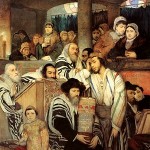The Yeshivah on high
 Just before Kol Nidrei comes the short paragraph, Biy’shivah shel ma’alah – “In the yeshivah on high”.
Just before Kol Nidrei comes the short paragraph, Biy’shivah shel ma’alah – “In the yeshivah on high”.
It doesn’t talk of a yeshivah in the modern sense but a session (from the word y-sh-v, to sit) held in heaven and endorsed on earth, where the decision is made to permit prayer with transgressors.
This formula has no real connection with Kol Nidrei, nor does the theory that it derives from the time of the Spanish Inquisition have any historical basis. The originator of the passage was Rabbi Meir of Rothenburg who died at the end of the 13th century.
By “transgressors” he meant people who had been permanently or temporarily excommunicated because they had offended against the Torah or against community regulations.
Normally such people were not allowed to pray with the congregation, or if they did it had to be at a distance. On Yom Kippur the rabbis were more lenient, apart from the practical difficulty of preserving the gap between the transgressors and the rest of the congregation in a packed synagogue.
The transgressions that had been committed were sometimes because antisemitism and intolerance had forced the individuals concerned to compromise their religious or communal identity. The rabbis’ sympathy for such people might express the principle, “There but for the grace of God go I”.
Whether this explanation is true or not, there was certainly a recognition that on Yom Kippur when everyone should tell the truth there is no Jew who is perfect in the sight of God.
Regardless of the visible transgressors, there were always individuals who in their private lives had failed to live up to the Almighty’s standards, and they too had to be regarded as transgressors.



